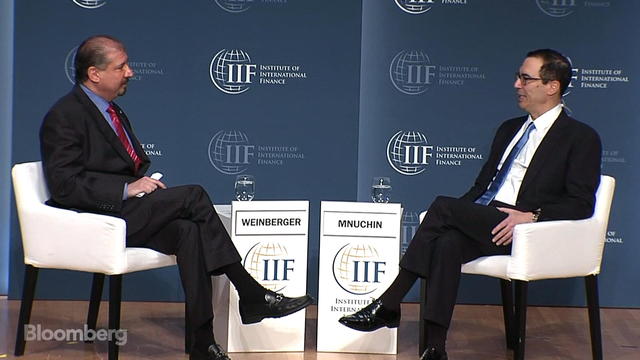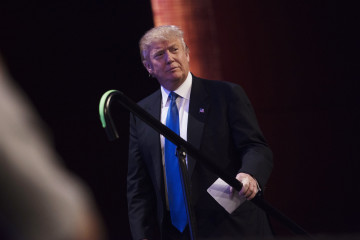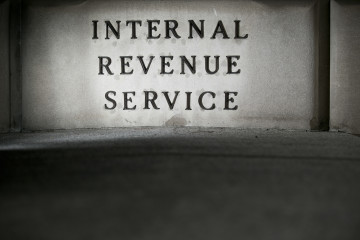Mnuchin Says Tax Overhaul Plan Will Happen by Year’s End

(Bloomberg) —The Trump administration is aiming to complete the biggest overhaul of the tax code since President Ronald Reagan by the end of the year, even if a second attempt to repeal the Affordable Care Act fails, according to Treasury Secretary Steven Mnuchin.
“Whether health care gets done or doesn’t get done, we’re going to get tax reform done,” Mnuchin said Thursday at a conference in Washington. “We’re pretty close to being able to bring forward what is going to be major tax reform.”
The dollar and U.S. stocks rose after Mnuchin’s comments, which came as the White House and congressional Republicans are at odds over whether to try for another vote on replacing the 2010 Affordable Care Act, known as Obamacare, next week. President Donald Trump has said he wants to get a health-care bill completed first before moving onto taxes.
White House economic adviser Gary Cohn said he and Mnuchin are spending a lot of time working together on tax policy and that there would be a “united proposal” coming from the Trump administration. While he didn’t specify timing of a tax plan, he said earlier this month the administration is still committed to passing a plan to overhaul the tax code this year.
In Congress, the tax-writing House Ways and Means Committee has been struggling to get support for a tax blueprint that House Speaker Paul Ryan released in June. Both House Republicans and the White House broadly agree on rate cuts for individuals and businesses. The Trump administration hasn’t yet said whether it supports the House’s controversial border adjustment proposal to replace the 35 percent corporate rate with a 20 percent tax on domestic goods and imports, while exempting exports.
Border-Adjusted Tax
Retailers, automakers and oil refiners that rely on imported materials have all complained that border adjustments would mean higher prices for consumer goods.
“There are certain things we like” about the border-adjusted tax, but “there are certain things we don’t,” Mnuchin said. He cited concern over currency adjustments that underpin the proposal. Proponents of the tax say the U.S. dollar would rise 25 percent to offset the higher price of imported goods.
“If the currency does correct in a much stronger currency, then that hurts our exports, if the currency doesn’t correct, we have price appreciation and inflation particularly in consumer goods, then that’s a concern,” he said. “We’re working with the House and having discussions on the specifics of it.”
Trump has made clear that he’s not fond of the phrase “border-adjusted tax.” It remains to be seen whether the president’s recent remarks on the concept signal that he’ll support import tariffs instead — that is, taxes levied on specific goods or countries at varying rates.
During his remarks on Thursday, Cohn said the administration wants a trade policy that’s “free, open, fair.”
“We should be reciprocal,” Cohn said. “If you want to insist on having a tariff on our product, the president believes we should treat you in a reciprocal fashion.”
Revenue Neutral
The border-adjusted tax is estimated to raise more than $1 trillion in revenue over a decade, which could help pay for cuts to the individual and corporate tax rates that Trump and House Republicans want. Achieving a “revenue neutral” plan — that is, one that doesn’t increase the deficit — may become an important goal for the White House if it can’t secure bipartisan support for a tax bill in the Senate, where Republicans control 52 of the 100 seats. Normal Senate rules create a 60-vote threshold for legislation to escape filibusters.
Senate Republicans could use a process known as budget reconciliation, which would allow for passing the tax bill with a simple majority. But under that process, any legislation that added to the deficit would have to be set to expire after 10 years.
Mnuchin said the White House’s tax plan wouldn’t increase the deficit because lower rates would be mostly offset by economic growth that would keep revenue steady. The plan would also trim deductions and simplify taxes generally — aiding the goal of revenue neutrality, he said.
The revenue effect of any tax plan would be evaluated under what’s called “dynamic scoring,” which means the impact of the tax policies on economic growth and consumer well-being would be taken into account. The process can be controversial, in that economists use differing models to gauge such outcomes. Mnuchin made clear that Trump administration officials “fundamentally believe in dynamic scoring.”
Cohn also emphasized the importance of dynamic scoring — saying it might help the administration’s plan avoid the pitfall of expiring after 10 years. “Using dynamic scoring may allow us to get to a permanent solution,” he said.
Tax Brackets
Mnuchin said Trump’s tax priorities are to simplify personal taxes, create middle-class tax cuts and make business taxes competitive. Both Trump’s campaign plan and the House Republican proposal would collapse the existing seven existing income tax brackets into three, with a top rate of 33 percent. Mnuchin said Thursday that administration officials are looking at whether there should be four brackets instead of three.
Mnuchin has said previously rewriting the tax code will offer “no absolute tax cut” for the upper class — even though independent analysts have said that the president’s plan for individual taxes — like the House Republicans’ — would provide more benefit to the wealthy than to the middle class.
To contact the reporters on this story: Lynnley Browning in New York at lbrowning4@bloomberg.net ;Saleha Mohsin in Washington at smohsin2@bloomberg.net To contact the editors responsible for this story: Alexis Leondis at aleondis@bloomberg.net John Voskuhl







No Comment